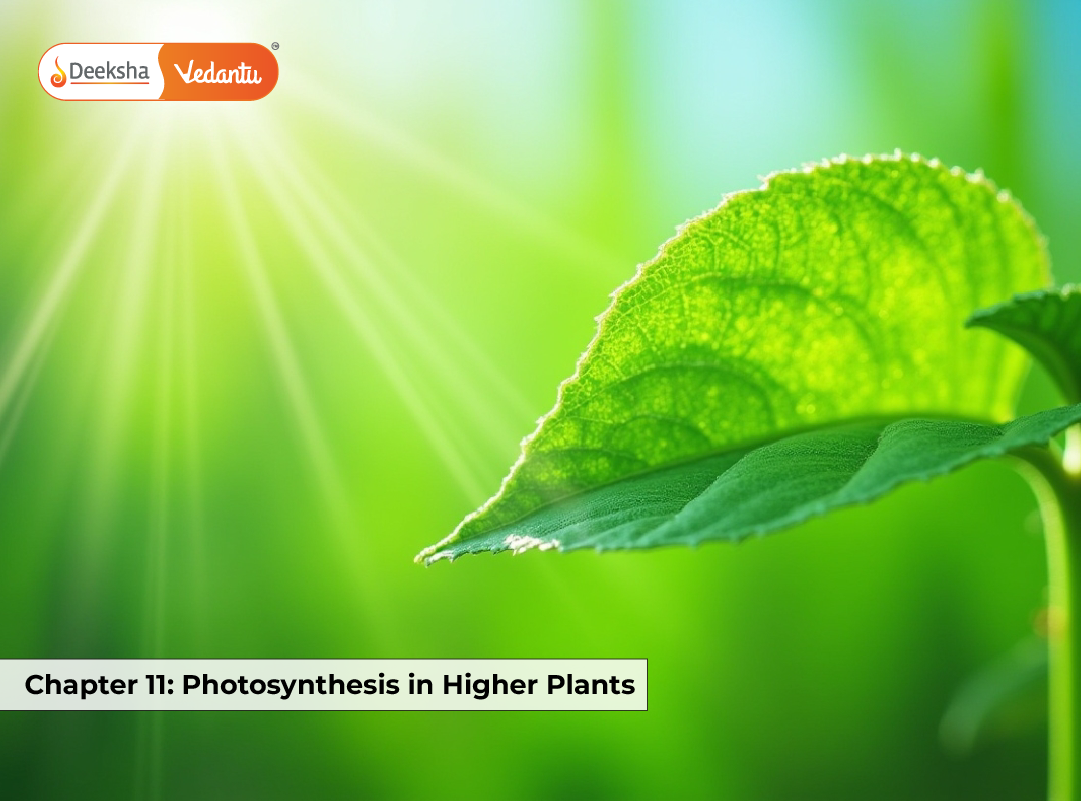Photosynthesis is one of the most tested concepts in NEET Biology due to its relevance in plant physiology, energy transformation, and biochemical cycles. This chapter focuses on how green plants use sunlight to synthesize organic food from carbon dioxide and water. Understanding the light and dark reactions, the Z-scheme, the Calvin cycle, and the differences between C3, C4, and CAM pathways is essential for scoring well.
This chapter falls under Unit IV – Plant Physiology and is crucial for both NEET and foundational topics in Class 12 Biology. From the molecular action of chlorophyll to the evolution of oxygen, each subtopic connects to real-life plant survival strategies and ecosystem-level energy flow.
What is Photosynthesis?
Photosynthesis is the biochemical process by which green plants, algae, and some bacteria convert light energy into chemical energy. The general equation for photosynthesis is:
6CO₂ + 12H₂O → C₆H₁₂O₆ + 6O₂ + 6H₂O
In plants, this process occurs in chloroplasts and involves two major phases:
- Light Reaction (Photochemical Phase): Occurs in the thylakoid membranes where light energy is captured to produce ATP and NADPH.
- Dark Reaction (Biosynthetic Phase): Occurs in the stroma and involves the fixation of CO₂ into carbohydrates using the energy carriers from the light reaction.
In NEET, this section lays the groundwork for understanding more complex reactions. Many MCQs are framed from this fundamental definition, its equation, and the role of different cell organelles.
The Early Experiments
This section covers key experiments that helped unravel the mystery of photosynthesis:
- Joseph Priestley (1770): Demonstrated that a plant could restore the air that a burning candle or breathing animal had depleted.
- Jan Ingenhousz (1779): Showed that light is essential for photosynthesis and that only the green parts of the plant produce oxygen.
- Julius von Sachs (1854): Proved that glucose is stored as starch in green parts and starch formation is indicative of photosynthesis.
- T.W. Engelmann (1888): Identified the action spectrum using a filamentous alga and aerobic bacteria. Found that maximum photosynthesis occurred in blue and red light.
These historical experiments frequently appear in NEET as one-liner MCQs or assertion-reason type questions.
Where Does Photosynthesis Take Place?
Photosynthesis occurs in chloroplasts, predominantly in the mesophyll cells of leaves.
- The grana are stacks of thylakoids where the light reaction takes place.
- The stroma is the matrix where the dark reaction or Calvin cycle occurs.
Key Points for NEET:
- Thylakoid membranes are the sites for photolysis of water and electron transport.
- Chloroplasts contain chlorophyll, which absorbs light, primarily in the red and blue wavelengths.
- Understanding chloroplast ultrastructure is critical, as NEET often includes diagram-based questions from this section.
How Many Pigments Are Involved in Photosynthesis?
Photosynthetic pigments are molecules that absorb light and convert it into chemical energy. The primary pigment is chlorophyll-a, which plays a direct role in the light reaction. Other accessory pigments include chlorophyll-b, xanthophylls, and carotenoids.
Types of Pigments:
- Chlorophyll-a: Blue-green; essential for photochemical reactions
- Chlorophyll-b: Yellow-green; helps in expanding the absorption spectrum
- Carotenoids (Carotenes + Xanthophylls): Protect chlorophyll from photooxidative damage and absorb in different regions of the spectrum
NEET Connection: MCQs commonly test the absorption spectrum vs. action spectrum, and the identification of the primary pigment involved in photolysis.
What is Light Reaction?
Light reaction, or the photochemical phase, occurs in the thylakoid membranes of the chloroplast and requires light. It involves several interconnected processes:
- Photolysis of Water: Splitting of water into electrons, protons, and oxygen with the help of light and the oxygen-evolving complex (OEC)
- Excitation of Chlorophyll: Absorbed light excites electrons in chlorophyll, which are transferred through an electron transport chain (ETC)
- Formation of ATP and NADPH: ATP is formed through photophosphorylation (cyclic and non-cyclic), and NADP⁺ gets reduced to NADPH
Overall Reaction of Light Reaction:
2H₂O + 2NADP⁺ + 3ADP + 3Pi → O₂ + 2NADPH + 3ATP
NEET Tip: Questions on cyclic vs non-cyclic photophosphorylation, products formed, and location of the light reaction are frequently asked.
The Electron Transport
Electron transport involves the movement of electrons through a series of carriers embedded in the thylakoid membrane. This system includes:
- Photosystem II (PSII): Absorbs light at 680 nm (P680) and initiates electron transport by oxidizing water
- Electron Transport Chain (ETC): Transfers electrons from PSII → plastoquinone (PQ) → cytochrome b₆f → plastocyanin (PC) → PSI
- Photosystem I (PSI): Absorbs light at 700 nm (P700); further excites electrons which are used to reduce NADP⁺ to NADPH
The flow of electrons follows the Z-scheme, a crucial diagram often asked in NEET. This flow leads to proton pumping across the thylakoid membrane, which drives ATP synthesis via chemiosmosis.
Important for NEET: Diagram-based questions on the Z-scheme, ATP/NADPH formation points, and sequence of electron carriers are highly testable.
Sub-topics of Electron Transport
The electron transport in photosynthesis can be categorized into two major types:
- Non-Cyclic Photophosphorylation:
- Involves both Photosystem II and Photosystem I
- Produces ATP, NADPH, and O₂
- Electrons lost from PSII are replaced by photolysis of water
- Follows the Z-scheme model
- This is the predominant pathway in plants
- Cyclic Photophosphorylation:
- Involves only Photosystem I (P700)
- Produces only ATP (no NADPH or O₂ is generated)
- Electrons return to PSI after passing through electron carriers
- Seen when NADP⁺ is not available or under high light intensity
Comparison for NEET:
| Feature | Cyclic Photophosphorylation | Non-Cyclic Photophosphorylation |
| Photosystems involved | Only PSI | Both PSII and PSI |
| Oxygen evolution | No | Yes |
| NADPH formation | No | Yes |
| ATP formation | Yes | Yes |
| Electron recycling | Yes | No |
Diagram-based MCQs or assertion-reason type questions based on this comparison are frequently asked in NEET.
Where are the ATP and NADPH Used?
ATP and NADPH generated during the light reaction are utilized in the Calvin cycle (dark reaction), which occurs in the stroma of the chloroplast.
- ATP provides energy for the fixation and reduction steps.
- NADPH provides reducing power to convert 3-phosphoglyceric acid (3-PGA) to glyceraldehyde-3-phosphate (G3P).
Overall Purpose: Convert atmospheric CO₂ into glucose using the ATP and NADPH from light reactions.
NEET Angle: Often tested through the energy budget of the Calvin cycle: 18 ATP and 12 NADPH are required for the synthesis of one molecule of glucose.
The C4 Pathway
C₄ photosynthesis is an adaptation in certain plants to overcome photorespiration, especially in high light intensity, high temperature, and low CO₂ conditions.
- Key Plants: Maize, Sugarcane, Sorghum (NEET favorite examples)
- Site of CO₂ fixation:
- Mesophyll Cells: CO₂ is initially fixed into a 4-carbon compound (oxaloacetic acid)
- Bundle Sheath Cells: Decarboxylation releases CO₂ for the Calvin cycle
Key Enzyme: PEP carboxylase (more affinity for CO₂, no oxygenase activity)
Advantages of C4 Pathway:
- Minimizes photorespiration
- More efficient carbon fixation in hot climates
NEET Pointers:
- Comparison of C3 vs C4 plants (including Kranz anatomy)
- Energy requirement of C4 is higher (30 ATPs per glucose)
Photorespiration
Photorespiration is a wasteful pathway where RuBisCO fixes O₂ instead of CO₂, especially under low CO₂/high O₂ conditions.
- Result: Energy is spent without producing sugars
- Key Organelles Involved: Chloroplast, Peroxisome, and Mitochondria
Why It Happens: RuBisCO has a dual function:
- Carboxylase activity (good – fixes CO₂)
- Oxygenase activity (bad – initiates photorespiration)
NEET Focus Areas:
- Role of RuBisCO
- Comparison between photosynthesis and photorespiration
- Organelles involved in photorespiratory pathway
Factors Affecting Photosynthesis
Photosynthesis is influenced by a variety of external and internal factors, and understanding these is vital for interpreting plant behavior and answering NEET application-based questions.
External Factors:
- Light Intensity:
- Rate of photosynthesis increases with light intensity up to a point.
- Beyond saturation, the rate plateaus.
- NEET often tests the concept of light saturation point.
- Carbon Dioxide Concentration:
- CO₂ is often the limiting factor in natural environments.
- Increased CO₂ leads to higher photosynthetic rates up to a certain threshold.
- Temperature:
- Has an optimal range (usually 25–35°C for most plants).
- Too high or low temperature inhibits enzyme activity.
- Water Availability:
- Water stress leads to stomatal closure, reducing CO₂ uptake.
- Indirectly affects the photosynthesis rate.
Internal Factors:
- Chlorophyll Content: More pigment equals greater light absorption.
- Leaf Anatomy: Size, shape, and arrangement of chloroplasts affect light capture.
- Enzyme Concentration: Especially RuBisCO and PEP carboxylase levels.
Blackman’s Law of Limiting Factors:
- Describes how the rate of photosynthesis is limited by the slowest factor.
- NEET sometimes includes assertion-reason questions from this principle.
NEET Insight: Graph-based MCQs based on the effect of light, CO₂, or temperature on photosynthesis are common.
NEET Illustrative Questions
- Which pigment is directly involved in the photochemical reaction?
- A) Chlorophyll-a
- B) Chlorophyll-b
- C) Xanthophyll
- D) Carotene
Answer: A
- Which enzyme is responsible for fixing CO₂ in the C4 pathway?
- A) RuBisCO
- B) PEP carboxylase
- C) Hexokinase
- D) NADP reductase
Answer: B
- In which part of the chloroplast does the Calvin cycle occur?
- A) Grana
- B) Thylakoid membrane
- C) Stroma
- D) Outer membrane
Answer: C
- Which of the following is not involved in photorespiration?
- A) Mitochondria
- B) Chloroplast
- C) Peroxisome
- D) Ribosome
Answer: D
FAQs
1. What is the most important pigment in photosynthesis for NEET?
Chlorophyll-a is the primary pigment because it directly participates in the light reaction.
2. How is the Z-scheme relevant to NEET exam questions?
The Z-scheme represents the path of electron flow and is commonly asked in diagram-based MCQs.
3. Why is photorespiration considered a wasteful process?
It consumes energy and oxygen without producing ATP or glucose, reducing overall photosynthetic efficiency.
4. How do C4 plants minimize photorespiration?
They spatially separate CO₂ fixation and the Calvin cycle, using PEP carboxylase with higher CO₂ affinity.
5. Which environmental factor is most commonly limiting photosynthesis in nature?
Carbon dioxide concentration is usually the limiting factor.
Conclusion
Mastering photosynthesis from the NEET perspective involves more than just memorizing pathways. It requires understanding the structural basis of chloroplasts, the functionality of different pigments and enzymes, and real-world adaptations like C4 and CAM. With frequent diagram-based and concept application questions, this chapter is a high-weightage, high-reward area in NEET Biology. Focus on mastering the light and dark reactions, enzyme roles, and regulation mechanisms to confidently tackle all related NEET questions.




Get Social